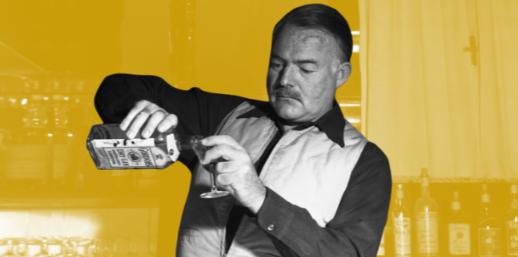
Photo: Esquire.com
As suggested by my last couple of posts, I’ve been reading a lot of F. Scott Fitzgerald. This, naturally, got me thinking about authors and alcohol. While Googling the subject, I came across a great post on a website called The Kitchn. It lists the the favorite cocktails of famous authors. This should be required reading for anyone who enjoys a good book and a strong libation (preferably at the same time). Here’s the list as it appears on The Kitchn (click here for the full article)—complete with nice literary quotes. Indeed, drinking should be educational.
Ernest Hemingway: The Mojito – Hemingway is associated with a number of cocktails (he was, after all, a heavy drinker), but none more so than the Mojito. According to Hemingway & Bailey’s Bartending Guide, the mojito was invented at La Bodeguita del Medio in Havana, Cuba, where Hemingway drank them.
“My mojito in the Bodeguita del Medio and my daiquiri in the Floridita.” – Ernest Hemingway, a signed quote hung on the wall of La Bodeguita del Medio in Havana, Cuba
William Faulkner: The Mint Julep – Faulkner’s Mint Julep recipe, as seen in Rowan Oak, the estate where William Faulkner lived from 1930 until his death in 1962, consisted of whiskey, 1 tsp sugar, ice, and a sprig or two of crushed mint, served in a metal cup.
“Isn’t anythin’ Ah got whiskey won’t cure.” – William Faulkner
Scott Fitzgerald: The Gin Rickey– It’s rumored that Fitzgerald’s passion for gin stemmed from his belief that you could not detect it on his breath. Traditionally a rickey is made with gin, but it can also be made with scotch or rum.
“First you take a drink, then the drink takes a drink, then the drink takes you.” – F. Scott Fitzgerald
Raymond Chandler: The Gimlet – The gimlet didn’t catch on in America until Chandler’s detective Philip Marlowe introduced it in The Long Goodbye.
“A real gimlet is half gin and half Rose’s lime juice and nothing else.” – Terry Lennox in Raymond Chandler’s The Long Goodbye
Ian Fleming: The Vesper Martini – In Fleming’s Bond series, the Vesper Martini is the first drink Bond ever orders – and the only time he orders it. The Vesper differs from Bond’s standard cocktail of choice, the martini, in that it uses both gin and vodka. Bond would later be known for ordering vodka martinis. (Interesting side note: in total, Bond orders 19 vodka martinis and 16 gin martinis throughout Fleming’s novels and short stories.)
“A dry martini… One. In a deep Champagne goblet…Just a moment. Three measures of Gordon’s, one of vodka, half a measure of Kina Lillet. Shake it very well until it’s ice-cold, then add a large thin slice of lemon peel. Got it?” – James Bond
Truman Capote: The Screwdriver – Capote is said to have called the Screwdriver—made with vodka, orange juice, and orange slices—”my orange drink.”
“In this profession it’s a long walk between drinks.” – Truman Capote
Edna St. Vincent Millay: The “Between the Sheets” – The story goes that Edna St. Vincent Millay, while writing and drinking late one night with Edmund Wilson and the poet John Peale Bishop, asked the men to hold her in their arms, one holding her lower half, the other her upper. Thus, the seductive “Between the Sheets” cocktail, which is basically a Sidecar with rum.
“Ah, drink again
This river that is the taker-away of pain,
And the giver-back of beauty!” – Edna St. Vincent MillayJohn Steinbeck: The Jack Rose – Also known as “Jersey Lightning,” the Jack Rose is for “the brandy drinker who also happen[s] to be a champion of the working class,” according to Hemingway & Bailey’s Bartending Guide. It was Steinbeck’s favorite drink.
“I have always lived violently, drunk hugely, eaten too much or not at all, slept around the clock or missed two nights of sleeping, worked too hard and too long in glory, or slobbed for a time in utter laziness. I’ve lifted, pulled, chopped, climbed, made love with joy and taken my hangovers as a consequence, not as a punishment.” – John Steinbeck in Travels with Charley
Jack Kerouac: The Margarita – Kerouac is said to have developed a taste for margaritas during one of his many trips through Mexico, a country and culture he loved.
“Don’t drink to get drunk. Drink to enjoy life.” – Jack Kerouac
Tennessee Williams: The Ramos Gin Fizz – Are you from New Orleans? Apparently folks there still drink this famous Southern cocktail in honor of Williams. The drink was featured many times in his writings. The standard recipe contains egg, cream, lemon and lime juice, sugar, gin (of course), and a bit of orange flower soda water.
